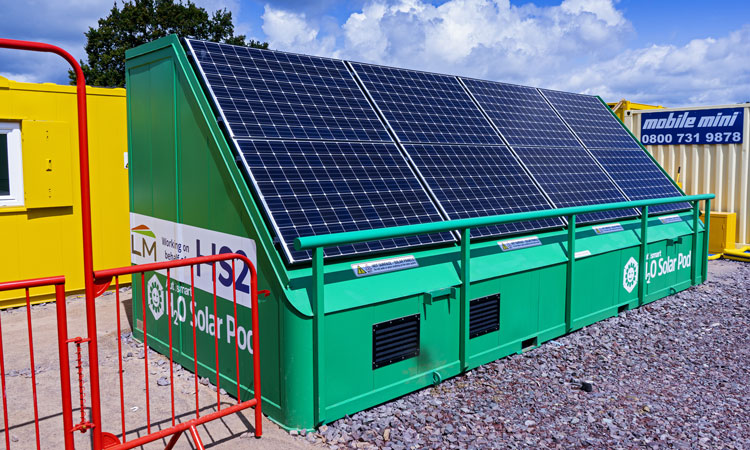HS2 details plans to improve air quality on Clean Air Day 2020
Posted: 8 October 2020 | Global Railway Review | 1 comment
The project aims to cut emissions and carbon on its construction sites, and to create a greener way of designing and building the new railway.


Solar Pod, supplied by Nixon Plant Hire, to supply electricity and hot water to site accommodation.
On Clean Air Day 2020, HS2 has listed 10 ways it is raising the bar on air quality during construction and operation.
Once built, HS2 will enable the shift from road and air to rail, improving air quality and supporting the transition to a net-zero carbon economy by 2050. Powered by electricity from the national grid, the railway will not emit air pollutants such as nitrogen oxide or particulate matter during operation.
In order to substantially reduce its carbon footprint, HS2 is implementing innovations to reduce emissions in the designing and building of the railway. Numerous initiatives have been developed with partners and academics, with more in the pipeline in a bid to create greener construction sites.
These include new plant emissions reduction strategies that will not only cut pollution, but bring time and cost savings, better reliability, and give assurance to local authorities and the public that the strict emission requirements are being met, to ensure air quality is safe for both the public and workers.
In addition, British-made products such as solar powered cabins are being rolled out across sites to dramatically reduce the project’s emissions, bringing environmental benefits to local communities along the route.
“HS2 is supporting the UK’s green economic recovery and ensuring the UK is on track to achieve its commitment to reach net zero carbon emissions by 2050,” commented Neil Wait, HS2’s Air Quality Manager. “As the country’s largest infrastructure project, we’re pleased to be supporting Clean Air Day – the UK’s largest air pollution campaign, and are working with our partners and supply chain to improve the quality of air for everyone as we build HS2.
Ten ways in which HS2 is striving to improve air quality standards
‘Designing out’ emissions
Emissions are being ‘designed out’ of HS2 buildings, with stations and depots using green technologies to cut carbon. For example, Curzon Street station has over 40 opportunities for carbon reduction, resulting in a reduction in the station’s lifetime emissions by over 87,000 tonnes of CO2 equivalent – that’s the same as removing the emissions of over 10,000 houses, or the equivalent of travelling 500 million kilometres in a car. Interchange station also makes use of renewable technologies, and in operation, the station will use natural ventilation, daylight, harvested rainwater and solar energy to cut carbon.
Transporting materials by freight trains
HS2 is cutting emissions by transporting materials by freight train, with 15,000 freight trains set to move 10 million tonnes of aggregate for HS2 over next 10 years. Every freight delivery replaces 70 lorries – dramatically cutting carbon emissions of HS2’s construction. HS2 has worked closely with Network Rail, the Main Works Civils Contractors, and Freight Operators for a number of years to make this possible, and to deliver on the project’s commitment to move as much material as possible by rail rather than road to help benefit the environment.
Introducing renewable energy on construction sites
HS2 has trialled the world’s first solar and hydrogen powered welfare cabins across construction sites, already cutting over 100 tonnes of carbon. The EasyCabin EcoSmart ZERO product is the world’s first solar and hydrogen powered welfare unit, combining solar and hydrogen power to eliminate carbon emissions from construction sites, and is set to be rolled out further across the HS2 project.
Pioneering electric, zero-pollution machinery
HS2 is pioneering the UK’s first electric telehandler on one of its major construction sites in London. With zero pollution, the Eco Telehandler vehicle has been trialled on HS2’s site at West Ruislip by main works civils contractor Skanska Costain STRABAG Joint Venture. It’s estimated that over a week, it saved over 400 litres of fuel compared to a traditional combustion telehandler. By cutting pollution from emissions completely, it creates greener construction sites, improving air quality for workers and the local community.
Setting standards for the lowest vehicle emissions levels
HS2 has set standards for the lowest emission levels available for all contractors’ vehicle engines, as well as set targets for contractors to go beyond this as technology improves, and has also set industry leading emissions standards for all machinery including excavators, dumpers, large cranes and piling machines.
Strict dust control
HS2 has set strict requirements for all contractors to control and limit their dust, air pollution, odour and exhaust emissions during works. Contractors use a range of dust management methods including damping down using mobile water sprayers, handheld hoses and water cannons to trap pollutants and stop them from escaping into the air.
Adopting a new plant emissions scheme
HS2 is encouraging the supply chain to adopt a new plant emissions scheme, developed in conjunction with the Construction Equipment Association (CEA). The new CESAR ECV system is a ‘bolt-on’ product, complimenting the existing CESAR security system, which allows quick and easy verification of a machine’s emissions category and helps ensure that emissions from plant are reduced where it cannot be avoided.
Rigorous monitoring of air quality
HS2’s air quality monitoring surveys add to existing national and local ones by Defra, local authorities, communities and academic institutions. Monitors on and around sites are used to measure the level of dust, with trigger alerts which provide near real-time feedback to contractors when dust concentrations reach a set level, allowing quick response and mitigation.
Ambitious plans to change industry best practice
HS2 has set ambitious targets for the supply chain to minimise emissions, and to develop best practise solutions to drive down emissions across the whole construction industry. For example, the Institute of Air Quality Management Guidance on Monitoring in the vicinity of Demolition and Construction Sites (October 2018) was updated following HS2’s study with Kings College London to evaluate construction site monitoring strategies.
New Non-Road Mobile Machinery (NRMM) low emission technology
A project is underway with academic partners to develop an innovative NRMM retrofit which will add technology to existing exhaust and engine systems and recertify them as a newer engine class. This will reduce exhaust emissions and improve air quality for communities, the environment and our workforce, as well as bringing significant cost savings.
Related topics
Electric/Hybrid Rolling Stock, High Speed Two (HS2), Route Development, Sustainability/Decarbonisation








Quality Air 2020 if endorsed with Karachi, Pakistan, the freight be shifted to Rail means a lot of pollution, noise included. If this comes on we’re in business, peacefully.